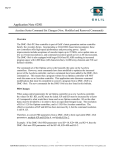Download MADA-2000 Media Audio Distribution Amplifier (Press Patch)
Transcript
MADA-2000 Owners Manual Rev A 7/1/99 9181 Chesapeake Drive • San Diego, CA 92123 • (858) 560-4162 • (858) 560-1923 Fax MADA-2000 Media Audio Distribution Amplifier Lift Mic Output dBm Unbal Lift Line Mic Unbal Line Mic Unbal Line Lift Lift Mic Unbal Line Mic Unbal Line Lift Media Audio Distribution Amplifer Lift Mic Unbal Line Lift Mic Line Unbal Lift Mic Unbal Lift Line Mic Unbal Line Mic Unbal Line Lift MADA-2000 Monitor Level -6 0 +6 +12 +18 Monitor Headset Output Why put up with the necessity of placing numerous unsightly microphones on a podium, that block the sight lines to the speaker, just to provide recording feeds to print and TV reporters. With the MADA-2000 there only needs to be one microphone to provide that recording feed. The Media Audio Distribution Amplifier is an audio mixing & distribution amplifier that is capable of supplying audio to reporters and sound cameramen at press conferences. The amplifier/mixer portion of the MADA2000 provides two (2) microphone and one (1) line inputs which in turn feed the mixed signal to ten fully insolated microphone or line level outputs. Each output is equipped with assorted standard connectors assuring easy access by the media. Other uses include: “on locations” recording, interfacing large audio systems at conventions, and isolating signals in applications where AC ground currents might present problems. The MADA-2000 features up to 60db of gain... low output noise (-90db)...low distortion (less than .25% THD at full rated output) and flat frequency response(+/-0.5db 24-18kHz). The MADA-2000 amplifier is self-contained with it’s own power supply and features differential balanced inputs with Op-Amp transformer isolated outputs. Isolation between outputs is well over 100db. All outputs, including headset monitoring jack, monitor level control and Bar LED level indicators are located on the front panel. Each of the ten (10) outputs are independently selectable to line or microphone level with each having selectable ground isolation to solve ground current problems. The rear panel contain’s XLR input connectors, phantom power control, mixing level controls and LED system level indicators. Link in/link out connectors are also mounted on the rear panel, enabling cascading MADA2000’s to allow for multiple input and outputs. The MADA-2000 is designed for standard EIA 19” rack mounting and requires 3.5” of vertical rack space. Specifications Type: Audio Distribution Amplifier Frequency Response: +/- .5db - 24 Hz to 18kHz Inputs: Two balanced microphone inputs One balanced line input Input Source Impedance: Microphone 1k ohms Line 7.5k ohms Number of Outputs: Ten (10) Line/Mic selectable Link Connection: 600 ohms 0dbm Maximum Gain: 60db, continuously variable Maximum Output: +20dbm into 600 ohms Nominal(system) Output: +4dm into 600 ohms (Line) -60dbm into 1k ohms (Mic) Output Source Impedance: 600 ohms (line) 220 ohms (mic) Distortion (THD): .25% at maximum rated output Signal to Noise Ratio (=4dbm): 90db, 24 hz - 18khz 600 ohms source, 600 ohm load, unweighted Isolation Between Outputs: 100db, 30 hz - 18khz Output Metering: LED Bar Graph: Green(below 6db), Yellow (+15db), Red (+21db) Output Monitoring: Headphone Jack 600 to 1500 ohms stereo Connections: Inputs: XLR female 3 pin Outputs: XLR male 3 pin, 1/8” mini phone, ¼” phone Dimensions: 19” w x 3.5” h x 4.5” d 47.5cm x 8.75cm x 11.25cm Weight: 6lbs (2.7 kg) Power Requirements: 106 - 130 VAC, 50-60Hz 25 watts Congratulations on your purchase of the Communications Company MADA-2000 Media Audio Distribution Amplifier! The MADA-2000 is an audio press patch (aka newsbridge), which allows distribution of up to three audio sources to multiple press recording devices. It may also be used as an audio distribution amplifier and an isolation device in difficult grounding sites. The MADA-2000 functions as both a mixer pre-amplifier and distribution amplifier. The mixer is comprised of two Microphone (150 Ω) inputs and one Line(600 Ω) input. The MADA-2000 will mix the 3 input signals, then amplify that signal to either -56dBm for microphone or +4dBm for line level and distribute that signal to the ten outputs. The mixing stage of the MADA-2000 has a maximum of 60 dB of gain available. The distribution section is equipped with ten transformer isolated outputs for microphone and line. Each output is provided with a 3 pin Male XLR receptacle, a 1/4” phone jack , a 1/8” mini phone jack, a ground lift switch and a microphone/line level selector switch. How to use the MADA-2000 The MADA-2000 is a very simple and forgiving device to use. Just plug in the source microphone(s), adjust the output level using the built in LED meters then plug in your recording devices. 1) INPUT CONTROLS: There are three independent inputs on the rear of the MADA-2000. Two are Microphone level (150 Ω, XLR-F) and these are designed to have a podium microphone directly plugged into them. There are individually selectable phantom power (+15 Vdc) available on each of the microphone inputs. The Line input (600 Ω, XLR-F), is designed to accept a feed from a mixer or house sound system. LINK OUT LINE LEVEL LINE IN MIC 2 LEVEL SYSTEM LEVEL INDICATOR HIGH OK MIC 1 LEVEL MIC 2 MIC 1 POWER LINK IN MIC 1 PHANTOM POWER MIC 2 PHANTOM POWER ON ON OFF OFF LOW 105-125VAC, 50/60Hz 1/4A SLOW-BLOW FUSE INSIDE MADA-2000 MEDIA AUDIO DISTRIBUTION AMPLIFIER S.N. WARNING: 210-250VAC, 50/60Hz DO NOT REMOVE COVER. NO USER SERVICEABLE PARTS INSIDE. REFER SERVICING TO QUALIFIED PERSONNEL. TO REDUSE RISK OF ELECTRIC SHOCK, DO NOT EXPOSE THIS APPLIANCE TO RAIN OR MOISTURE. 1/8A SLOW-BLOW FUSE INSIDE AVIS: RISQUE DE CHOC ELECTRIC. NE PAS OUVRIR. NOTE: All three inputs can be used simultaneously. Keep in mind that each input needs to be set at a level comparable to the other two, so that one is not louder, as there is no master volume control on the unit. 2) LEVEL SETTING: On the left rear of the MADA-2000 there are 3 LED’s: High(red), OK(green), Low(yellow). The LED’s are provided as an aid to set the output signal level. Adjust the rear input level control(s) to the point at which the OK (green) LED is on solid. This will indicate that the output level will be in the -6 to +6dB range which, under normal usage, is an appropriate output signal level. It is normal that the Red (high) and Yellow (low) LED’s will flicker as the signal level varies. Make sure the Red LED is not constantly on, as this would indicate an overdrive situation or the Yellow LED is not constantly on, as this would indicate a low signal situation. 3) OUTPUTS: On the front of the MADA-2000 are ten identical outputs, with the following features: Select the output level required, plug into the desired connector, and the signal will then be distributed to that user. MADA-2000 Media A 1/8" / 3.5mm Jack Line or Mic Output Selector XLR (M) Jack 1/4" / 6mm Jack Mic Line Lift Mic Unbal Line Lift 1 ea XLR 3 pin Male jack 1 ea 1/4” / 6.25mm 3 conductor TRS Phone jack 1 ea 1/8” / 3.5mm 3 conductor TRS Mini jack 1 ea Microphone (150 Ω) or line (600 Ω) output selector 1 ea Three position grounding Switch Ground Lift Switch 4) OUTPUT CONTROLS: The main output controls are on the front of the MADA-2000 and feature the following. A red power indicator LED that is lit when the MADA-2000 is powered. A headphone output jack with 8 watts of power and a volume control. This is provided to allow system monitoring and help with setup. Also on the front panel is a Bar Graph LED’s that mirror’s the action of the rear panel LED’s, but is more visually detailed. Headset Volume Control Output dBm Unbal Lift Power Indicator Monitor Level Output Level Meter -6 0 +6 +12 +18 1/4" Headset Phone Jack Monitor Headset Output LINK SECTION The MADA-2000 is provided with Link In and Link Out connectors on the rear of the unit. These connections allow multiple MADA-2000 units to be cascaded together to provide more outputs if needed. The Link Out connection is a XLR Male 3 pin and the Link In connection is a XLR Female 3 pin. This allows the use of standard microphone cables to make the connections. LINK OUT There is no practical limit on the number of MADA-2000’s that can be linked together. There have been several instances of ten MADA-2000’s linked without signal loss or audio degradation occurring. LINE IN MIC 2 LEVEL MIC 1 LEVEL MIC 2 HIGH OK MIC 1 LINK IN MIC 2 PHANTOM POWER MIC 1 PHANTOM POWER ON ON OFF OFF LOW MADA-2000 MEDIA AUDIO DISTRIBUTION AMPLIFIER LINK OUT Keep in mind the link circuit is not two way. If two microphones are plugged in to MADA #1 and a microphone is plugged in to MADA #2, the microphone in MADA #2 will not be distributed in MADA #1. However MADA #2 and all further units will be provided a mix of both MADA #1 and MADA #2. LINE LEVEL SYSTEM LEVEL INDICATOR LINE LEVEL LINE IN MIC 2 LEVEL MIC 1 LEVEL MIC 2 HIGH OK MIC 1 LINK IN MIC 2 PHANTOM POWER SYSTEM LEVEL INDICATOR MIC 1 PHANTOM POWER ON ON OFF OFF LOW MADA-2000 MEDIA AUDIO DISTRIBUTION AMPLIFIER LINK OUT LINE LEVEL LINE IN MIC 2 LEVEL SYSTEM LEVEL INDICATOR HIGH OK MIC 1 LEVEL MIC 2 MIC 2 PHANTOM POWER MIC 1 LINK IN MIC 1 PHANTOM POWER ON ON OFF OFF LOW MADA-2000 MEDIA AUDIO DISTRIBUTION AMPLIFIER MOUNTING The MADA-2000 is supplied in a standard 19” wide 3.5” high rack mount format. It’s 7.5” depth will fit into any standard EIA 19” rack . The unit also includes two handles that provide for ease of handing and protection of the connectors plugged into the front panel. If you plan to install the MADA-2000 in a transportation case, keep in mind the unit is only 7.5” deep, but potentially needs 4” of clearance on the front of the unit. The case should be ordered in a short depth model, to facilitate access to the rear connections and allow viewing of the rear mounted input level LED’s. POWER The MADA-2000 is powered by an on-board power supply that is wired from the factory at 120Vac 50/60Hz. The power supply can be easily changed to operate on 240Vac 50/60Hz by moving jumpers and exchanging a fuse located on the main PC board. The MADA-2000 can be ordered from our factory in the 240Vac configuration, just notify sales at time of order. If you need to make a change from 110/120Vac to 220/240Vac in the field, here are the steps involved: 1) UNPLUG the MADA-2000 from all power and remove the A/C cable from the rear of the unit. P1 Fuse 120V - 1/4 amp 250V - 1/8 amp 2) Remove the top of the unit. 3) With the output connections toward you, the power supply is located on the lower PC board on the left side. It will look similar to this diagram.====== >>>> Jumpers (110/120V) JP1 & JP2 F1 WARNING ! JP1 120V DO NOT INSTALL 240V JMPR UNLESS BOTH 120V JMPRS ARE REMOVED JP2 JP3 120V 4) Unsolder and remove jumpers JP1 and JP2, labeled 120V. C29 R43 240V R93 R93 Jumper (220/240V) JP3 C29 CAUTION ! TO REDUCE THE RISK OF FIRE, REPLACE "F1"FUSE ONLY WITH THE SAME TYPE AND RATING 105-125V OPERATION 1/4A 250V MDL 210-250V OPERATION 1/8A 250V MDL 5) Install and solder a new jumper at JP3, labeled 240V. 6) Replace the existing F1 fuse with a 1/8 amp, 250V MDL fuse. VR2 T11 VR1 C33 7) Do not remove any other jumpers. C31 C32 8) Re-Install the top of the unit. Mic/Line Diagram’s In Addendum #1 there are samples of connection wiring and standard patch cable wiring. These are industry standard wiring conventions and the MADA-2000 is designed around them. GROUNDING Almost all cases of hum or noise in audio systems can be traced back to ground loops and grounding problems. The MADA is subject to ground loops, as are all electronics units that have an on-board power supply. Some simple suggestions are: First and most important suggestion - Don’t clip the ground leg off the AC cord. The removal of the ground leg from a AC connector will substantially increase the chance of getting electrical shock, We don’t recommend or advocate removing the ground leg, as there is little proof this action will consistantly eliminate ground loop hum. Second Suggestion - Each of the ten outputs of the MADA has a three position grounding toggle switch, which is provided to help reduce grounding problems. Left - unbalances the connection Center - lifts pin 1 off the system ground buss Right - is the normal position: connection is balanced and pin 1 is routed to ground Move the grounding toggle switch between the 3 positions to see if it will eliminate the problem. Third suggestion - Do a full diagnostic of the system wiring. A) Unplug all input cables and re-insert them one at a time checking to see if the noise/hum is caused by that input. If so, look at the how the cable is wired and confirm that it is wired to industry standard microphone pin wiring. This is important because the MADA is designed and wired to the following industry standard wiring conventions: XLR Pin 1 = Shield/Ground Pin 2 = Hot “+” Pin 3 = Negative “-” ¼” Phone Tip = Hot “+” Ring = Negative “-” Sleeve = Shield/Ground 1/8” Mini Tip = Hot “+” Ring = Negative “-” Sleeve = Shield/Ground B) Unplug all output cables and then re-insert each one at a time, until the noise/hum reappears. This will allow you to identify the offending cable or piece of equipment. If it is not possible to remove the offending hum, then try the following: 1) Put an isolation transformer between the item and the MADA. 2) Look at the patch cord being used. Fourth suggestion A) Keep all cables short. B) Keep cables of the same signal type and level together. C) Keep cables of different signal levels apart. D) If cables are pigtailed - keep exposed conductors and copper as short as possible. E) Make sure that all patch cables are wired to industry standards. (See addendum #1) Since the subject of grounding could fill a large book, the above suggestions are a attempt to help with trouble shooting. We strongly suggest you research this audio area in greater depth. For more in-depth information on audio grounding, we have found the following books and technical papers to be of value: AES Journal - Vol 43 #6, June 1995 Glen Ballou - Handbook for Sound Engineers, The Audio Cyclopedia - ISBN 0240803310 Don & Carolyn Davis - Sound System Engineering - ISBN 0240803051 Rane Corporation - Tech Note #102 - Analog I/O Standards - Tech Note #110 - Sound System Interconnection Yamaha (Gary Davis & Ralph Jones) - Sound System Reinforcement Handbook - ISBN 0881889008 ( Jon Eiche) - A Guide to Sound Systems for Worship - ISBN 079350029X 1 2 2 1 3 3 RED RED BLACK BLACK Balanced XLR to XLR SHIELD 1 SHIELD 2 3 RED RED Balanced XLR to Balanced TRS Phone BLACK SHIELD 1 BLACK SHIELD 2 3 RED RED Balanced XLR to Unbalanced TS Phone BLACK SHIELD 1 BLACK SHIELD 2 3 RED RED Balanced XLR to Balanced 1/8" Mini BLACK SHIELD 1 BLACK SHIELD 2 3 RED RED Balanced XLR to Unbalanced Phono (RCA) BLACK SHIELD SHIELD Balanced TRS Phone Unbalanced TS Phone SHIELD Balanced TRS Phone Unbalanced Phono (RCA) TIP TIP RING BLACK SHIELD RED RED BLACK SHIELD RED RED BLACK BLACK BLACK SHIELD TIP RING SLEEVE SLEEVE 1/8" TRS PLUG 1/4" TRS PLUG SLEEVE = GROUND SLEEVE = GROUND RING = LOW RING = LOW TIP = HIGH TIP = HIGH SLEEVE RCA PLUG SLEEVE = GROUND & LOW TIP = HIGH TIP TIP 1 2 3 SLEEVE SLEEVE 1/8" TS PLUG 1/4" TS PLUG XLR 3 PIN PLUG SLEEVE = GROUND & LOW TIP = HIGH SLEEVE = GROUND & LOW TIP = HIGH PIN 1 = GROUND Courtesy of Rane Corporation PIN 2 = HIGH PIN 3 = LOW Addendum #1



















